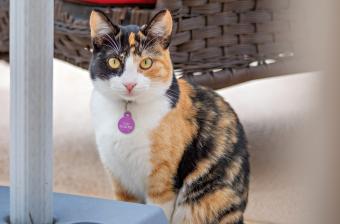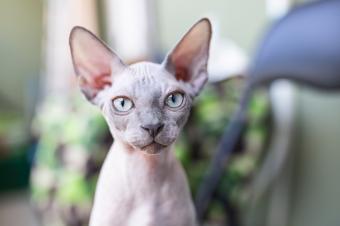
Calico cats aren't an actual cat breed. It's a common misconception, but calico is just a color pattern that occurs in many breeds of cats. You can find calico Persians, British shorthairs, and even calico Maine coons! But not every calico cat has the same coloring or patterns, because there are three distinct variations.
What Is a Calico Cat?
Calico cats have a combination of black, orange, and white fur. Each color has its own separate patches, and the colors are never blended or mixed like they are in tortoiseshell cats. Sometimes the colors are diluted to shades of blue, chocolate, cream, or fawn instead of the standard black and orange on white.
Although your cat's coat color isn't the only thing that impacts behavior, it may affect your cat's personality.
Calico Color Variations
Not all calico cats have the same coloring. There are actually three different types of tri-color combinations.
1. Traditional Calico

The traditional calico coloring that you know and love is tricolor with patches of orange, black, and white. Anywhere from 25 to 75 percent of their body can be white, but by definition they should have a white base in order to be considered a calico.
2. Dilute Calico

Diluted or muted calicos have coloring that's much lighter than the traditional calico. These cats have patches of gray, cream, and white. Sometimes the gray can appear as a blue shade, which is truly stunning. This coloring is rare to find.
3. Patched Tabby

A patched tabby is a cat with both calico and tabby coloring. Some people refer to them as tabicos (tabby + calico = tabico) or calbies (calico + tabby = caliby) just for fun. Regardless of what you call them, these rare cats have patches of white and orange like a traditional calico, but instead of black coloring, they have patches of tabby stripes.
Calico Vs. Tortoiseshell

A lot of people use the terms calico and tortoiseshell interchangeably, but they're not the same pattern. Calicos are always tricolor with a white base, whereas tortoiseshell cats have a black base with mottled orange throughout their coat, which looks like a tortoise's shell. What's confusing is that tortoiseshells can sometimes have small patches of white fur, but if the white is not the base color, they're technically not a calico.
Why Male Calicos Are Rare
The genetic code for color is contained in an X chromosome, and since most male cats are XY and only receive a single X chromosome, they don't carry the genetic coding to be calicos. However, there are rare occasions when a male calico cat inherits two X chromosomes, making him XXY and, therefore, able to present the calico pattern and coloring. This rarity is basically a genetic anomaly, and for this reason, the few male calicos you'll find are nearly always sterile and live a shorter lifespan.
Interesting Facts About Calico Cats
- Male calicos are called Klinefelter cats, after Dr. Harry Klinefelter, who discovered the XXY genetic combination.
- Did you know each U.S. state has an official state cat? Yep, and the calico is the state cat of Maryland!
- Your cat's calico pattern may make them a bit extra to deal with. A survey of cat owners revealed that calico cats seem to "challenge" their owners more than cats of other colors.
- Calico cats are believed to be a sign of good luck in Japan.
Enjoy Your Calico
Since calicos are such a popular color pattern, you'd think cat lovers would specifically breed for these beauties. In reality, this is not the case and you can't breed for this coloration. Calico cats remain a happy accident of genetics. So appreciate your patchwork kitty, not only for their beauty, but for the unusual genetic sequence that was necessary to produce them.







